#Joseph Shapiro
Note
I mean if it’s someone like Mark Wahlberg or Onision or Ben Shapiro then I’ll gladly cyberbully them and call them jumpscares but Joseph Quinn seems like such a sweet guy wtf
Homophobics, misogynistics and racists will never have my appreciation. It’s a fact. And I am only sorry if the fav of someone reading that answer fits that profile.
But Joseph is not like that, and he does not deserve to be attacked the way they are doing.
By the way, I detest the aforementioned people. Ew!
#ask box#people are so rude online#bullying#joseph quinn#cast#the fantastic four#hateful people#mark wahlberg#ben shapiro#onision#disgusting 🤮#ask anon#ask response
9 notes
·
View notes
Text
LUCY’S THIN BLUE LINE
Lucy and Law Enforcement ~ Part 2

On “The Lucy Show,” Lucy Carmichael not only had multiple run-ins with the police - she actually became one for a couple of episodes! Here’s a look at Carmichael and Cops!

“Lucy and Viv Become Tycoons” (1963) ~ When Lucy and Viv open their own business at home, they are visited by Sergeant Robbins (Bern Hoffman) to check on their permits and operating practices. In 1960, Hoddman appeared in the Lucille Ball / Bob Hope film The Facts of Life.

“Lucy Drives a Dump Truck” (1963) ~ Driving a truck to a nearby town, Lucy and Viv are pulled over by a Brewster policeman played by Richard Reeves, a veteran of nine episodes of “I Love Lucy” including playing a policeman in “Equal Rights” (1953). This is his only appearance on “The Lucy Show.”
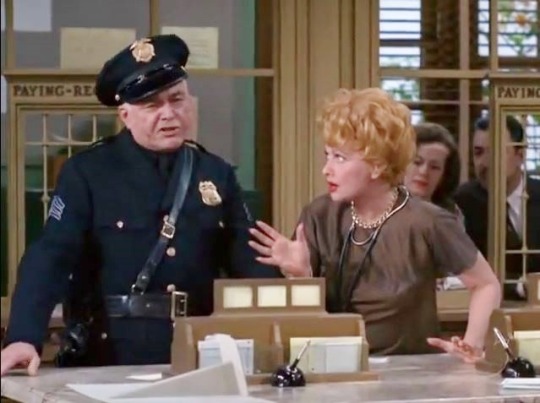
“Lucy and the Safe Cracker” (1963) ~ When Mr. Mooney gets locked in the safe (again), Lucy contacts a safe cracker (Jay Novello) and Sergeant Wilcox (James Flavin) is on the scene. Coincidentally, Flavin played the Immigration Officer searching for Mario Orsatti (Jay Novello) in “Visitor from Italy” (1956). He will return to “The Lucy Show” two episodes later to play Sgt. Wilcox again in another bank-themed episode. He appeared in four films with Lucille Ball, including playing a police sergeant in Without Love (1945). During his long career he played so many officers of the law that his IMDB photo is of him in a police uniform!

“Lucy and the Bank Scandal” (1963) ~ Sergeant Wilcox (James Flavin) investigates a case of embezzelment at the Danfield Bank. Lucy suspects Mr. Mooney and digs up his yard to find the stolen cash.
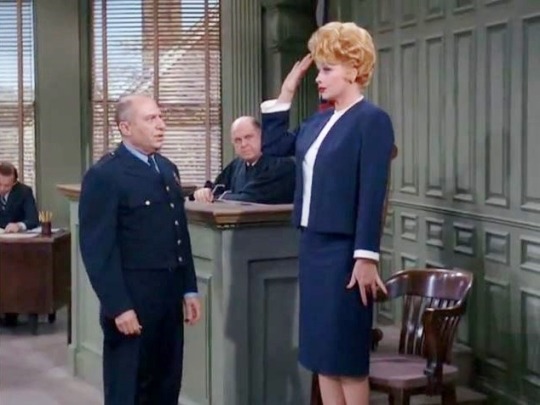
“Lucy is Her Own Lawyer” (1964) ~ Officer Joe (Joe Mell) the Baliff, swears in Lucy Carmichael as well as Mr. Mooney and Nelson the dog! Mell returns as a Baliff in “Lucy the Meter Maid” (1964) and a Bank Guard in “Lucy the Stockholder” (1965).
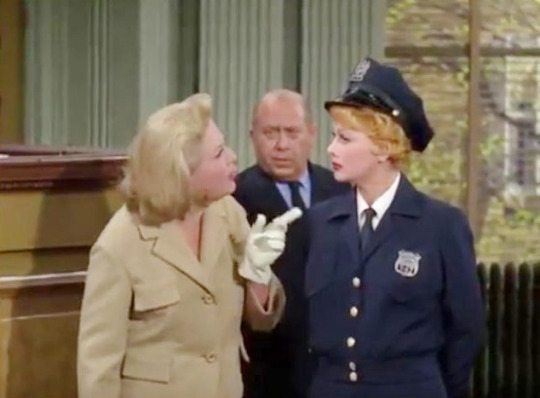
“Lucy the Meter Maid” (1964) ~ Lucy joins the Danfield Police Force as meter maid. When Viv doesn’t feed the meter, Lucy issues her a summons and they land up in court. Once again, Joe Mell plays the Baliff.

“Lucy Makes a Pinch” (1964) ~ Still on the Force, Lucy is recruited to be part of a stake out. The episode features three of Danfield’s finest (left to right): Murdock (Jack Searl), Captain Bradford (Alan Carney), and Detective Bill Baker (Jack Kelly). As a child actor, Jack Searl was featured in the 1932 film Officer Thirteen, about motorcyle cops. Alan Carney played a policeman in the 1963 comedy classic It’s a Mad, Mad, Mad, Mad World. In 1955, Jack Kelly appeared on a TV series titled “City Detective.”
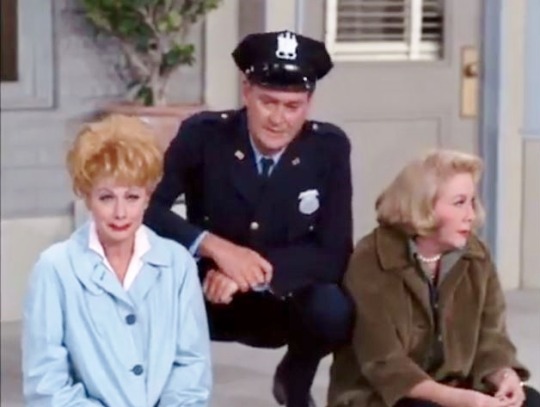
“Lucy the Coin Collector” (1964) ~ When Lucy drops a rare coin down the sewar grate, she is consoled by a cop on the beat (Ray Kellogg). his is the second of his seven episodes of “The Lucy Show.” He also did two episodes of “Here’s Lucy.” Just as in his other screen credits, most most times he played policemen, as he does here.

“Lucy and the Ceramic Cat” (1965) ~ While Lucy breaks into Bigelow’s Department Store, Viv stands guard, diverting the cop on the beat (John J. ‘Red’ Fox). Fox was best known for playing policemen, which is what he did on five of his eight appearances on “The Lucy Show” as well as three of his five episodes of “Here’s Lucy.”

“Lucy, the Stockholder” (1965) ~ After buying a single share of the Danfield Bank for $32, Lucy the stockholder pays the bank a visit. She warns the lackadaisical guard (Joe Mell) that she has a nine year-old nephew who is quicker on the draw than him.
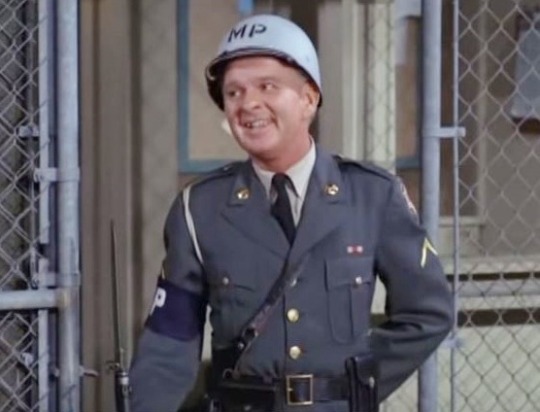
“Lucy and the Undercover Agent” (1965) ~ Trying to get access to performer Carol Channing, Lucy charms Military Police (MP) officer Sol Schwartz. The character name was specifically chosen so Lucy can sing “Hello, Solly” to the tune of “Hello, Dolly”.

“Salute to Stan Laurel” (1965) ~ In a special tributing the late comedian, Lucille Ball is part of a silent movie sketch featuring Buster Keaton and Harvey Korman as a policeman in the park.

“Lucy Meets Mickey Rooney” (1965) ~ A silent movie sketch based on Charlie Chaplin’s The Kid features the Keystone Kops (Sid Gould, above). Keystone Kops are fictional, humorously incompetent policemen featured in silent film slapstick comedies produced by Mack Sennett for his Keystone Film Company between 1912 and 1917.
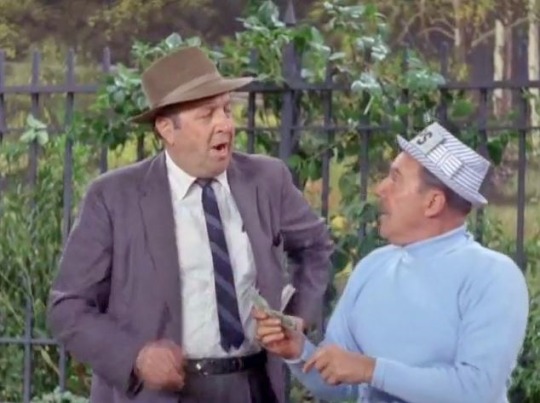
“Lucy Goes to a Hollywood Premiere” (1966) ~ Mr. Mooney is questioned by Officer Collins (Robert Foulk) of the Beverly Hills Police Department. He doesn’t have a permit to sell maps to the movie stars’ homes and is hauled down to the police station. Foulk played the Brooklyn policeman on the subway platform in “Lucy and the Loving Cup” (1956). He will go on to play six characters on “Here’s Lucy,” two of them policemen.

“Lucy the Gun Moll” (1966) ~ Robert Stack plays Federal Agent Briggs in this satire on Desilu’s “The Untouchables.” Stack played G-Man Eliot Ness on the series and only agreed to the satire if the names were changed.

“Lucy and the Submarine” (1966) ~ Whe Lucy sneaks onto a submarine, she must get by a stoic Navy Shore Patrolman (SP) played by Steven Marlo. Marlo makes the first of his two appearances on “The Lucy Show.”

“Lucy and the Ring-a-Ding Ring” (1966) ~ Ray Kellogg plays the cop on the beat who discovers Mr. Mooney trying to get a nearly unconscious Lucy into his car because she has his wife’s ring stuck on her finger.
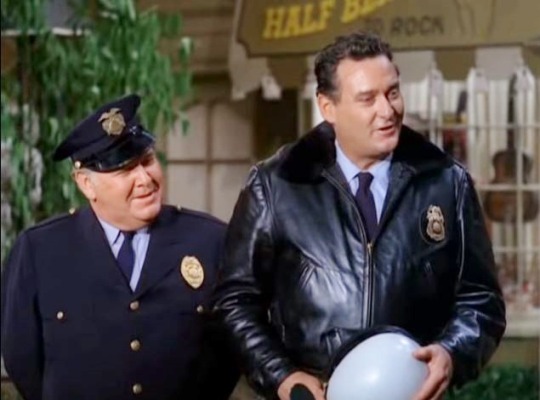
“Viv Visits Lucy” (1967) ~ To find a wayward Danfield boy, Lucy and Viv go to the Sunset Strip, where they are mistaken for hippie biker chicks by the police. Ray Kellogg plays the Motorcycle Officer (right) and John J. 'Red’ Fox plays Patrolman Harry McLeod (left).
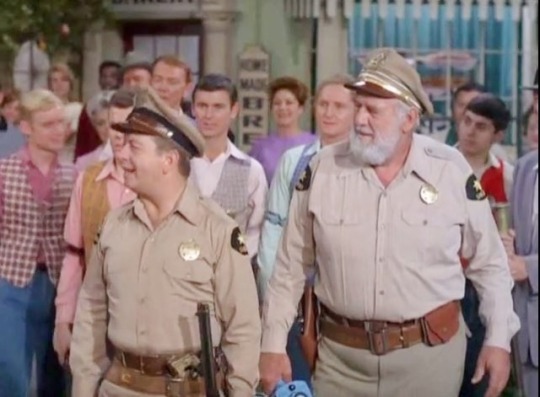
“Lucy Puts Main Street on the Map” (1967) ~ Mel Torme is Mel Tinker, the deputy and Roy Barcroft plays his father, Police Chief Tinker, the law enforcement team in small town Bancroft. During his long career on screen, Barcroft played a sheriff 18 times between 1943 and 1966, including in Billy the Kid Versus Dracula (1966).

“Lucy Meets the Law” (1967) ~ Lucy thinks she’s being arrested for littering when she is actually being mistaken for a red-haired jewel thief. Claude Akins (Lieutenant Finch) is perhaps best remembered for playing Sheriff Lobo in “B.J. And the Bear” (1978-79) and its sequel “The Misadventures of Sheriff Lobo” (1979-81).

Jody Gilbert plays the jail matron aka ‘Tinkerbell’. Gilbert will also appear in two episodes of “Here’s Lucy,” in one of which she also plays a prison matron.

Ken Lynch (Officer Peters, left) started playing policemen on TV in 1950 and continued to do so for much of his career. Joseph Perry (Officer Miller, right) started his screen acting career in 1956. Perry played a policeman on “My Living Doll” (1965) filmed at Desilu. He appeared on the police-themed shows “Policewoman,” “Police Story,” “Barney Miller,” “Hill Street Blues,” “CHiPs,” “The Rookies” “The Mod Squad,” “87th Precinct,” “The FBI,” “The Rookies,” and “The Sheriff of Cochise” a Desilu Production.

“Lucy Sues Mooney” (1967) ~ Irwin Charone (Bailiff) makes the third of his five appearances on “The Lucy Show.”
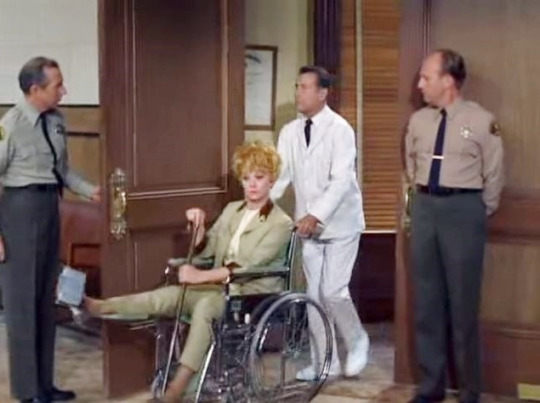
Two uncredited background actors play Officers of the Court.

“Lucy and the Stolen Stole” (1968) ~ Lucy and Mr. Mooney go shopping for Mrs. Mooney's birthday and wind up being arrested for possession of a stolen fur stole. The boys in blue are played by Ray Kellogg, Roy Shapiro, and John J. 'Red' Fox as Officer Shapiro.
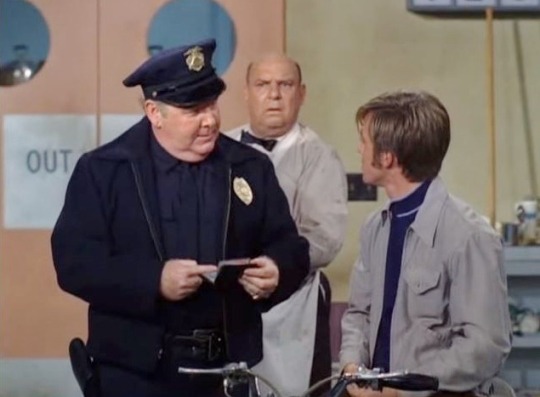
“Lucy Gets Involved” (1968) ~ At Phil’s Fat Boy Burgers, a policeman (John J. 'Red' Fox) interrogates motorcyclist Tommy Watkins (Phil Vandervoort) with Mr. Burton (Jackie Coogan) overhearing.

“Lucy and Sid Caesar” (1968) ~ A forger who looks like Sid Caesar is passing bad checks at the bank. Lucy and Mr. Mooney try to figure out how to tell the real Sid Caesar from the forger. They enlist the help of the authorities (left to right): Irwin Charrone, John J. ‘Red’ Fox, and Ben Gage. Gage was mentioned on “I Love Lucy” in 1955. He appeared on “Our Miss Brooks” (filmed at Desilu Studios) and in Desilu’s “Star Trek.” His last two screen appearances were in “Policewoman” and “Police Story.”
#Police#Lucille Ball#Lucy#The Lucy Show#TV#CBS#Sid Caesar#Ben Gage#Irwin Sharrone#John J. 'Red' Fox#Ray Kellogg#Roy Shapiro#Ken Lynch#Joseph Perry#Jody Gilbert#Claude Akins#Mel Torme#Roy Barcroft#Steven Marlo#Bern Hoffmann#Richard Reeves#James Flavin#Joe Mell#Jack Searle#Alan Carney#Jack Kelly#Robert Stack#Robert Foulk#Gale Gordon#Harvey Korman
6 notes
·
View notes
Text

Bad movie I have Rag Doll 2019
#Rag Doll#Shannon Murray#Stephanie Erb#Dot-Marie Jones#Dante Basco#Roxana Sanchez#Hope Shapiro#Lateefah Holder#Dana Pacheco#Eddie Alfano#Hugh B. Holub#I. Elijah Baughman#Luis Jose Lopez#Theodore Mark Martinez#Julian Graham#Charlie Schlatter#Heather Higginbotham#Mark Schaefer#Anika C. McFall#Mike C. Nelson#John Handem Piette#Joseph Bezenek#Shy Pilgreen#Caitlin Brandes#Katie Schwartz#Dominique Vance#Arden Banks#Nikka Ischelle#Fahad Olayan#Lee Rodgers
1 note
·
View note
Text
little life update my books on the disability rights movement came in the mail today very exciting also i got to play with legos in my sculpture class.
#the books is No Pity: People with Disabilities Forging a New Civil Rights Movement by Joseph p. Shapiro#<- no relation to that other guy#i love you thriftbooks
1 note
·
View note
Text
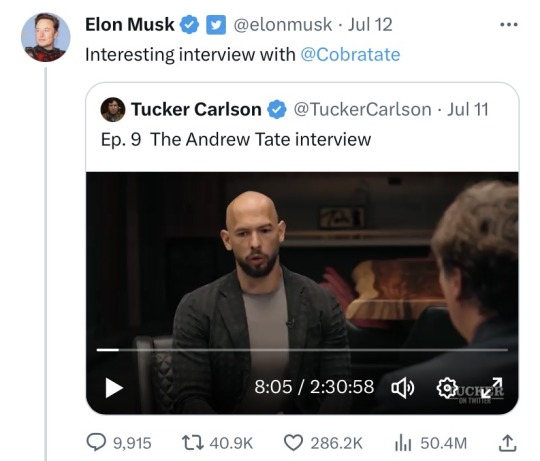
Tucker Carlson's interview with misogynist, human trafficker and rapist Andrew Tate has been endorsed by Elon Musk, the man who brought Tate among many other reactionary and far-right commentators back to Twitter when he purchased the platform.
There is nothing spontaneous about Musk doing this, and if you're surprised then you're a fool. This has never been about upholding free speech - hence why you've never seen any of these men promote interesting left-wing thinkers.
The ‘SJW’/‘woke’/progressive Left, as unbearably annoying as so many of them are, just keep getting proven right.
They said Nick Fuentes and Kanye were Holocaust-denying anti-semites.
They said Jordan Peterson supported rapists, and didn't believe women should have legal equality.
They said Ben Shapiro and Matt Walsh would use the gender critical movement to blame gay people and women for any and all degeneracies.
They said Tucker Carlson and Elon Musk's recent ‘free speech’ moves were about repositioning themselves so that they could more effectively elevate the voices of overt extremists.
Again and again, their accusations are ageing like fine wine. The reactionary right’s mask is well and fully off.
Andrew Tate, Elon Musk, Tucker Carlson, Jordan Peterson, Ben Shapiro, Matt Walsh, Joe Rogan, Konstantin Kissin, Paul Joseph Watson, Ian Miles Cheong, Andy Ngo, Michael Malice, Elijah Schaffer, Zuby, Milo Yionnopoulous, Tommy Robinson, Nick Fuentes, Kanye West, Donald Trump… obviously some of these men could dislike each other, I can't imagine Shapiro and Fuentes at the same house party.
But their ideal societies don't look too different. None of these mens’ do. Because any racial, religious or ethnic prejudices they have against each other will come second to their common-ground.
The organised reaction against this brand of progressivism that has rapidly come to monopolise every sector of public life in the last 10 years, is well and truly underway. Musk, Carlson and Tate have given us the sign. And while I pretty heavily dislike the current ‘woke’ progressive ideology (and have a lot of questions about its top-down cultural spread), I'm scared of these guys way more. And if you're anything but a straight man who doesn’t care about any demographic besides straight men, you should be too.
The reason I say ‘straight men’ and not ‘straight white men’ is because, come on, the reactionary right is more racially diverse than most left-wing groups at this point. 😂😂 White nationalists the world over have bent the knee to a mixed-race man who admitted moving to an Eastern European country because of their more lax laws on sexual assault, and in turn, the ease he would have in exploiting the local women in the country’s already active sex-trafficking trade.
White nationalists (whose role in the reactionary right cannot be discarded any more, after Trump and Kanye had a personal dinner with Nick Fuentes) feel more of an affiliation with a non-white, human trafficking violent rapist, despite evidence of his crimes having been public for a while now, than they do with his WHITE victims.
Jordan Peterson, whose daughter has revolved her entire public image around him, who works with and for him, and whose lingerie photographs were retweeted by him, made a dogwhistle in May about women having their right to vote retracted.
Examples of men devaluing the contributions and rights of the women in their families, communities and wider societies are withstanding the test of time, over and over again, because no matter where in the world they are, and no matter what tensions the different religions, cultures, ethnicities and races of men have with each other, there are traits that unite them all. Misogyny is the most obvious one.
The men of these diverse, far-reaching societies, in many ways feel far more of a kinship to each other, than they do to any woman, girl, gay person, disabled person, mother, child, or any other demographic.
The pendulum always swings back, and now that we know these men have got the owner of the world's biggest social media platform on their side, that is a major sign it could be coming soon. Be on guard and look after each other gyns ❤️
217 notes
·
View notes
Text
An essay I wrote for school on Strange New Worlds' problems with ableism, complete with bibliography:
Star Trek: Strange New Worlds has numerous problems, from its retooling of the Gorn into knockoff xenomorphs to its erasure of Spock’s Jewish roots to its overreliance on nostalgia, but its most glaring flaw is its painful undercurrent of ableism. The conflation of disability with death, the ignorance and tacit pardoning of eugenics, and the disposal of multiple disabled characters come together to weave a harmful and ignorant pattern in the show’s writing.
Christopher Pike’s character in Strange New Worlds is defined by disability. The dilemma he wrestles with in almost every episode is the looming specter of his future disability, which was revealed to him via time crystal in season two of Star Trek: Discovery. In the twelfth episode of season two, “Through The Valley of Shadows”, Pike must harvest a time crystal in order to send the life’s story of a dead alien to the future to protect it from an evil artificial intelligence intent on destroying all life in the galaxy. When Pike touches the crystal, he sees visions of his future, in which he is caught in a deadly radioactive explosion and left with severe burns and full body paralysis, able to move and communicate only through a specialized wheelchair. “The sequence ends with a final linked pair of nightmarish shots, a centred close-up of the older Pike’s face beginning to melt as he screams matched with the younger Pike’s own horrified scream as he falls backward into the present moment,” (Muredda, Angelo). As Muredda says later in the same article, this portrayal imagines disability as “a terminal point, something to scream about in terror, and the embodied sign of no liveable future at all.” The depiction of disability as a horrifying fate, and of the disabled body as an object of disgust and/or fear has a long history in the genres of horror and science fiction; previous and current Star Trek series are not immune to this. The Borg Queen, who appeared most recently in Picard, is missing most of her lower body and uses a robotic replacement to walk— her prosthetic spine is used as an object of horror and disgust when she first appears in First Contact (1996).
While Strange New Worlds had the opportunity to break this pattern and defy ableist stereotypes with Pike, they chose instead to follow the path Discovery had laid for them. Despite the fact that it is made very clear that Pike will be disabled, not killed, by the explosion he will be caught in in the future, every character within the narrative speaks of Pike’s fate as if he is going to die. Pike says, less than twenty minutes into the pilot: “I know how and when my life will end.” This writing decision mirrors the real-life belief that disabled peoples’ lives are akin to “a fate worse than death” or “not worth living,” a sentiment which has led to real deaths: “. . . [early in the pandemic] this belief — that we’re just surviving, not living, and thus have limited quality of life — lead to forced DNRs being put in the files of disabled people in the UK and lead directly to the death of a disabled man, Michael Hickson,” (Lloyd, Kelas). Hickson was denied treatment for pneumonia in Austin, Texas due to his doctor’s perception that he “didn’t have much of a quality of life.” He was put in hospice against his family’s wishes and died at the age of 46. (Shapiro, Joseph). For Strange New Worlds to equate Pike’s disability to the end of his life is irresponsible and reinforces the cultural biases that led to the death of Hickson and continue to impact the quality of treatment disabled people receive the world over.
Christopher Pike’s initial appearance in the original series episode “The Menagerie” was actually very progressive for the time; despite the limited communication of the blinking-light system in his wheelchair and his ending being living out the last of his life in a virtual reality where he could walk again, he was still a disabled person on television in a position of power.
When Pike first appeared, the Ugly Laws were still in place in much of the United States. Someone visibly disfigured/disabled was not to be seen in public spaces, at the risk of fines or jail . . . Captain Pike’s appearance in The Original Series was revolutionary. Here was not just a visibly disabled person, but they were someone Spock respected and cared about enough to risk his career for. [Disabled people] didn’t have a great existence, but they had one, and Pike was still valued as a person. (Lloyd, Kelas).
It would have been quite easy for the writers to modernize Pike’s portrayal to further disability representation in the way Pike first did: @hard-times-paramore has written an alternate ending (a mixed media series titled “The Captain’s Chair”) for Strange New Worlds in which Pike goes on to captain a new starship after becoming disabled, assisted by an interpreter, a caretaker, and futuristic medical technology. This alternate ending carries the message that disabled people are still people, who can and should be allowed a place in science fiction, as opposed to the current message sent by SNW, which is that significant disability is akin to a death sentence, even in a fantastical future.
However, there is more to Strange New Worlds’ portrayal of disability than just Captain Pike. The show is also very preoccupied with genetic augmentation and the Federation’s attitude toward it. While this is far from unique among Star Trek media, unlike other Trek properties which have covered this topic (Doctor Bashir, I Presume?, Chrysalis, Space Seed, Affliction/Divergence, etc) Strange New Worlds does not acknowledge the real-life equivalent to science fiction genetic augmentation: eugenics. SNW portrays genetic augmentation as a neutral practice targeted unjustly by the Federation because of outdated prejudices, with no examination of what genetic augmentation is a stand-in for. While the original series (in “Space Seed”) first introduced the Federation’s ban on genetic augmentation as a justified protective measure against the breeding of warlike “superior ambition” among men of “superior ability,” Strange New Worlds portrays genetic augmentation as an unjustly discriminated-against trait whose origin and consequences mean little to nothing.
Strange New Worlds’ main conduit for their genetic augmentation plotlines is Una Chin-Riley, the first officer of the Enterprise. She is a member of an alien species called Illyrians, who genetically modify themselves to suit the environments of planets they colonize. She herself was genetically modified as a baby, and is thus legally barred from joining Starfleet— however, she lied on her application to Starfleet Academy to get in. The plots revolving around her concern her arrest for violating Federation law and the subsequent trial, which is used as an extended metaphor for discrimination against, and the fight for civil rights for, marginalized groups. “Ad Astra Per Aspera,” the episode covering Una’s trial, is intentionally vague with its metaphor, to the point that just about any marginalized group could be represented by it. This episode is, on its face, fine. It argues against discrimination through allegory quite adeptly, discussing the concept of “passing” as part of a non-oppressed group and broaching the topic of systemic oppression. However, it has one glaring flaw in its base: the stand-in it chose for real-life oppression. Genetic modification, unlike other fantastical attributes that can be used to metaphorize oppression, has a bloody real-life history involving the deaths and sterilizations of millions of people. Strange New Worlds, however, appears ignorant of this fact: not once does the topic of eugenics come up in any of their episodes about genetic augmentation. Not once does the topic of disability come up, either. This is either an unwillingness to engage with the realities of what those who seek to change humanity’s genes have done and continue to do, a grave oversight, or mere ignorance. Whichever one it is, this omission of eugenics from the narrative of genetic augmentation is one that cannot be ignored. Its omission reads as a tacit endorsement of genetic augmentation at times, such as when Una and La’An say, in “Ghosts of Illyria”:
LA’AN: All my life I've hated augments. Hated what people thought of me because I was related to them. Understanding why they were outlawed in the Federation. The damage they did. They almost destroyed Earth.
UNA: [. . .] My people were never motivated by domination. Illyrians seek collaboration with nature. By bioengineering our bodies, we adapt to naturally-existing habitats. Instead of terraforming planets, we modify ourselves. And there's nothing wrong with that.
By ignoring the part eugenics plays in Star Trek’s portrayal of augmentation, and instead portraying the issue as a matter of prejudice based off of the fictional event of the Eugenics Wars— when augmented “supermen” became dictators and killed millions in conquest and war— Strange New Worlds completely fails to examine the real-life implications of their metaphor.
What makes this episode’s flaws worse is that another Star Trek series already portrayed the potential expulsion of a genetically augmented person from Starfleet, handling it with better understanding of the eugenic undertones of genetic augmentation, and it did so in 1997. In the season five episode of Deep Space Nine, “Doctor Bashir, I Presume?”, it is revealed that Julian Bashir, chief medical officer of Deep Space Nine, was illegally genetically modified by his parents as a small child and is in danger of being thrown out of Starfleet because of this revelation. Throughout the course of the episode, the audience learns that Bashir’s parents chose to modify him because he was intellectually disabled as a child. His mother believed that his life would be better if he were “normal,” while his father wanted a successful son and believed that intellectual disability was inimical to that end. The episode expresses, through Julian’s anger at his parents, that modifying a person to rid them of perceived “undesirable traits” is wrong, but that it is also wrong to unilaterally bar people from Starfleet based on a decision that was made for them by eugenicist parents. This message is far more clear than “Ad Astra Per Aspera”’s, especially on the subject of disability and eugenics. Strange New Worlds’ complete neutrality on and/or tacit approval of genetic augmentation/eugenics, in contrast to Deep Space Nine’s nuanced examination of the topic, is glaring.
The specific problem with Strange New Worlds’ neutrality on genetic modification is that for a species to be changed on a genetic level for any reason, traits must be eliminated. In a science fiction setting, this can be accomplished by simply changing the genetic structure of a consenting adult with a futuristic medical tool, rather than through violence as in our reality, but this, too, presents ethical problems. What is considered a problem to be cured? Who makes that decision? What happens to those who don’t want something modified out of them? What happens to any children they may have? Who gets to have control over technology with the power to eliminate or introduce genetic traits at will? What place do disabled people have in a society built off of achieving peak physical performance in a given environment? Strange New Worlds attempts to answer none of these questions. It acknowledges none of them. And this silence leaves disabled people out of the conversation completely by not even considering them. Today, in Denmark and Iceland, almost 100% of fetuses with Down Syndrome are aborted; the law in Iceland even specifically states that abortion is permitted after 16 weeks only if the fetus has a “deformity,” which Down Syndrome is specified to count as. (Quinones, Julian; Lajka, Arijeta). An entire anti-vaccine movement was begun in Britain because parents were so afraid of having a child with autism and chronic digestive disease, a child like me, that they risked their children dying of measles. This is what real-life genetic engineering looks like, and Strange New Worlds has failed to acknowledge that. I, at least, consider that a failure of writing, empathy, and allyship.
Strange New Worlds’ portrayal of disability is not relegated to Pike’s fate and Una’s augmentation, however. The show has several other characters who either are disabled or become disabled at one point. Rukiya, Dr. M’Benga’s daughter, is treated less as a character and more as an object for the emotional development of her father, a position many young disabled girls occupy in fiction. “[This story] centers Dr. M’Benga, and his pain, and his struggle, and doesn’t grapple with what Rukiya’s going through.” (Lloyd, Kelas). Rukiya has an untreatable terminal cancer, and is kept in a state of suspension in the transporter buffer by her father while he searches for a cure. Her story ends when the Enterprise enters a sentient telepathic nebula with the power to warp reality, and it offers to keep Rukiya within itself so that her disease will not progress and she will be able to grow up. M’Benga decides that this is the best option, and so relinquishes Rukiya to the nebula. She is never seen again. “She is disabled, and then she’s removed . . . The disabled person was put into [a] box and left behind, like so many disabled people have been put away in care homes and institutions and left behind.” (Lloyd, Kelas). Jax agreed, saying: “It just felt like she was poofed away for convenience. Like, ‘There! The problem is gone! The terminal illness or the girl? Both! Don’t worry about it!’”
The only other disabled main character on SNW is Hemmer, who is a member of a blind species called the Aenar. “While the Aenar cannot see, they believe that their telepathy gives them a ‘superior’ awareness of their surroundings compared to sighted people (Vrvilo, 2022). Because of this, the Aenar are highly criticized by the disability community as falling into the ‘magically disabled’ trope.” (Harris, Heather Rose). Bruce Horak, the actor who plays Hemmer, is blind himself, which is a genuinely good decision in terms of representation and support for the disabled community. However, Hemmer dies in the penultimate episode of season one. This decision was not received well by disabled fans: “It just kind of felt like a kick in the teeth. I finally found some good disability representation played by a disabled actor [who] isn’t a one off character, and they die in the first season.” (Jax). Both Hemmer and Rukiya are left behind by the narrative of Strange New Worlds, and with them, so too are disabled perspectives. The crew of the Enterprise is now entirely able-bodied, and the only remaining character whose story directly concerns disability is Pike, who repeatedly asserts that his life will end once he becomes disabled. This state of affairs is the embodiment of being spoken for, and being spoken over.
There is a saying in the disabled community: “Nothing about us without us.” This saying means that abled people should not attempt to help, treat, or speak about disabled people without involving disabled people in their efforts. Disabled people are often denied autonomy over their bodies, medical care, relationships, and lives; to deny them a part in operations meant to help them is to further deny them dignity and respect. This is what Strange New Worlds is doing by writing disabled stories with no disabled writers in the room— while they did well by casting Bruce Horak to play Hemmer, it is not enough to have disabled people in front of the camera. They must also play a part in writing, directing, planning, and all other work behind the scenes if Strange New Worlds wishes to tell their stories. In order for Strange New Worlds to rectify their pattern of ableism, they must listen to disabled voices.
BIBLIOGRAPHY:
#star trek#star trek: strange new worlds#star trek snw#snw#strange new worlds#ableism#media analysis#disability#snw critical#this one is my tag
33 notes
·
View notes
Text

Competitors under cut (all matches were randomized except the first one)
@techno-danger vs The Presimint (@hellsite-hungergames) (aka me)
Ea-Nasir vs. Capitalism
The Wizard of Oz vs. Ron DeSantis
Tucker Carlson vs. Pikaman
Donald Trump vs. Mr. Monopoly
Mark Zuckerberg vs. King Charles
Light Yagami vs. Someone's Father named Dick
Marcus Junius Brutus vs. Zeus
Alberto Fugimori vs. Egg
Ted Cruz vs. Dream
Elon Musk vs. Barney the Dinosaur
Shinzo Abe vs. The United States
Julius Caesar vs. Catiline
Mike Pence vs. Ben Shapiro
Lex Luthor vs. God
Augusto Pinochet vs. Dr. Evilglaze
Mitch McConnell vs. Joe Biden
Ross Geller vs. y/n
Kim Jong-un vs. Jeff Bezos
Klaus Schwab vs. The Koch Brothers
Greg Abbott vs. The U.S. Healthcare System
Joey Drew vs. George Washington
Andrew Tate vs. Someone's Tio David
Ronald Reagan vs. Joseph Stalin's Mustache
Gordon Ramsay vs. Thomas Jefferson
Lin-Manuel Miranda vs. Jair Bolsonaro
Vladimir Putin vs. J.K. Rowling
Agamemnon vs. Alexander Hamilton
Scott Morrison vs. Someone's Grandpa
President Snow vs. Bruce Wayne
Emperor Palpatine vs. Santa Claus
Margaret Thatcher vs. Perry the Platypus
#ides of march#the ides of march#julius caesar#perry the platypus#margaret thatcher#santa claus#emperor palpatine#bruce wayne#president snow#hellsite hunger games#scott morrison#agamemnon#alexander hamilton#lin manuel miranda#vladimir putin#jkr#jair bolsonaro#thomas jefferson#gordon ramsay#joseph stalin#ronald reagan#andrew tate#george washington#joey drew#greg abbott#koch brothers#klaus schwab#jeff bezos#kim jong un#ross geller
65 notes
·
View notes
Quote
Judy Heumann was the first person I called when, in 1987, I reported my first story on disability rights. Judy, who contracted polio when she was 18 months old, gave me the quote that perfectly summed up that little-known civil rights movement.
"Disability only becomes a tragedy when society fails to provide the things we need to lead our lives — job opportunities or barrier-free buildings, for example," she said. "It is not a tragedy to me that I'm living in a wheelchair."
That idea seemed so unexpected and strange that my editors at a newsmagazine decided not to publish my story.
Joseph Shapiro quoting Judy Heumann in a beautiful obituary at NPR. Activist Judy Heumann led a reimagining of what it means to be disabled
Julia Métraux tweeted:
May Judith Heumann's memory be a blessing.
And let's make it the norm that disabled advocates are able to become disabled elders.
Being Heumann: An Unrepentant Memoir of a Disability Rights Activist
Judy Heuman Disability Rights Activist
80 notes
·
View notes
Text

She just wanted to make things better for everyone, her brother said.
She was called a “true force of nature”, a “rolling warrior” who never gave up, continuously fighting for what she believed in and inspiring everyone around her.
When she died this past week on March 4 at the age of 75, she was remembered as a major American civil rights hero.
She “was born in 1947 [in Philadelphia] to two parents who had separately fled Nazi Germany as children in the 1930s,” according to Philissa Cramer, writing for JTA. “All of her grandparents and countless other family members were murdered in the Holocaust.”
At the age of 18 months, she contracted polio, an infection so severe, she spent several months in an iron lung and lost her ability to walk, according to her brother.
She said she believed it was her parents’ experience that led them to reject doctors’ advice to have their daughter institutionalized after she lost the use of her legs, according to Cramer.
“They came from a country where families got separated, some children sent away, others taken from their families by the authorities and never returned — all part of a campaign of systematic dehumanization and murder,” she wrote in her memoir.
“The experience of fleeing Nazi Germany left the parents and their children with a passion.,” according to the Los Angeles Times.
“We truly believe,” her brother would say "that discrimination is wrong in any way, shape or form."
Susan Mizner, Director of the Disability Rights Program and Kendall Ciesemier, Host of At Liberty and Senior Executive Producer of Multimedia, American Civil Liberties Union, wrote:
“When [she] was born, the fight for civil rights didn’t include people with disabilities. Disabled people faced rampant discrimination and segregation in American life. Disabled people experienced high rates of unemployment and were taught in separate schools. Changing these institutions wasn’t just a calling for [her], it was a necessity. At a young age, [she] learned that the world did not see her the way she saw herself, and she spent the rest of her life committed to changing that.”
“The first time that I really remember someone making me feel different was when I was about eight years old,” she told April Coughlin in Story Corps. “My friend and I were going to the candy store. She was pushing my wheelchair, and this young boy came over to me and said, ‘Are you sick?’
“I wished the ground would open and swallow me up. It made me realize that people saw me differently than I saw myself.
~~~~~
NPR correspondent Joseph Shapiro wrote:
“When she was 5 and it was time to go to kindergarten, her parents . . . went to register her but were turned away at the nearby public school.
“It would create a fire hazard, the principal said, to let a girl in a wheelchair go to the school.
“Her mother . . . fought to end the isolating and erratic hours — just a few hours a week — of home instruction and eventually [she] was allowed into a school building.”
“Kids with disabilities were considered a hardship, economically and socially," she would later write.
She spent the rest of her life fighting, first to get access for herself and then for others, her brother recalled.
“Years later, [she] graduated from college where she studied to become a teacher. Being a speech therapist was one of the few professions, she was told, open to a young woman in a wheelchair,” continued Shapiro.
“But again, she was deemed a fire hazard. This time, in 1970, New York City's Board of Education ruled that a teacher in a wheelchair would be unable to evacuate children during an emergency and denied her a teaching license.
“Having learned from her mother's advocacy, [she] sued. She got support in the local press. "You Can Be President, Not Teacher, with Polio," ran one newspaper story, noting the presidency of Franklin Roosevelt.”
She said she wanted to see “feisty disabled people change the world”.
She did.
She “broke down barriers for disabled children and educators in New York City schools, protested until federal legislation protecting people with disabilities was passed and advised multiple presidential administrations on disability issues,” wrote Cramer.
Her tireless advocacy led to her being widely considered "the mother of the disability rights movement," the American Association of People with Disabilities wrote in a press release.
Her name is Judith Heumann.
This is a new story for the Jon S. Randal Peace Page. The Peace Page focuses on past and present stories seldom told of lives forgotten, ignored, or dismissed. The stories are gathered from writers, journalists, and historians to share awareness and foster understanding, to bring people together. And, as such, the stories this month for Women’s History Month are never relegated to one single month - they are available all year in the Peace Page archives and on this page each week throughout the year. We encourage you to learn more about the individuals and events mentioned here and to support the writers, educators, and historians whose words we present. Thank you for being here and helping us share awareness.
~~~~~
“Women have been making history for centuries; for some, this was the only choice they had. For women with disabilities in particular, it was either live the way others expected them to or fight for the lives they knew they (and all people with disabilities) deserved,” according to Melissa Young.
Judith Heumann “was perhaps most recognized in recent years from her appearance in the documentary ‘Crip Camp: A Disability Revolution’, which chronicled the forgotten history of a freewheeling summer camp called Camp Jened in upstate New York for teenagers with disabilities in the 1970s,” wrote Edwin Rios of The Guardian.
“Her experience at Camp Jened inspired a groundswell of US political activism and sparked a movement of young activists with disabilities who fought for civil rights protections at a time when they were treated like second-class citizens.”
She also wrote “Being Heumann: An Unrepentant Memoir of a Disability Rights Activist” and “Rolling Warrior: The Incredible, Sometimes Awkward, True Story of a Rebel Girl on Wheels Who Helped Spark a Revolution.”
Brian P.D. Hannon and Heather Hollingsworth of the Los Angeles Times wrote:
“She lobbied for legislation that eventually led to the federal Americans With Disabilities Act [and the] Individuals With Disabilities Education Act.
“Heumann also was involved in passage of the United Nations Convention on the Rights of Persons With Disabilities, which was ratified in May 2008.
She helped found the Berkeley Center for Independent Living, the Independent Living Movement and the World Institute on Disability and served on the boards of several related organizations, including the American Assn. of People With Disabilities, the Disability Rights Education and Defense Fund, Humanity and Inclusion and the United States International Council on Disability, according to her website.
“Judy pushed the international human rights community to focus on issues facing people with disabilities when confronting the world’s challenges — whether it be war, climate change, pandemics, poverty or anything else. She ensured that disability was included in the Country Reports on Human Rights Practices and was the first disabled person to serve on the board of Human Rights Watch,” wrote Rebecca Cokley, program officer for the US Disability Rights program at the Ford Foundation and co-founder and director of the Disability Justice initiative at the Center for American Progress.
“Along with 80 activists, and with a little help from the Black Panthers, Heumann staged a sit-in for 25 days, the longest sit-in at a federal building to date,” according to writer Lester Fabian Brathwaite. “As a result, regulations were passed enforcing the Rehabilitation Act.”
“It also served as a demonstrable show of force by a community previously framed by society and the media as weak, incapable and dependent. They were anything but that,” wrote Cokley.
“She would later serve as an advisor on disability rights to the Clinton administration, the World Bank, and the Obama administration,” added Brathwaite.
~~~~~
In NPR’s article:
Shantha Rau Barriga, disability rights director at Human Rights Watch, said in a statement Heumman was a “true force of nature”.
“She was a giant in the human rights movement and led with such integrity,” she added. “This loss will be felt far and wide but what a legacy she leaves behind.”
“Beyond all of the policy-making and legal battles that she helped win and fight, she really helped make it possible for disability to not be a bad thing, to make it OK to be disabled in the world and not be regarded as a person who needs to be in a separate, special place,” the president and CEO of the American Association of People with Disabilities, Maria Town, told the Hollywood Reporter.
Heumman said, “Disability only becomes a tragedy when society fails to provide the things we need to lead our lives – job opportunities or barrier-free buildings, for example . . . It is not a tragedy to me that I’m living in a wheelchair.”
She also said, “I wanna see a feisty group of disabled people around the world…if you don’t respect yourself and if you don’t demand what you believe in for yourself, you’re not gonna get it.”
“Judy is often referred to as the mother of the disability rights movement, and for good reason. Not only did she usher forward sweeping changes for disabled people around the world, she mentored, befriended, inspired, and empowered countless disabled people who now carry on her legacy,” wrote Mizner and Ciesemier.
“Hers was one of the first voices to tell us that we matter and that we are worth fighting for. Now, we continue the fight. Judy lives on in every disabled kid who gets to join their classmates in school and every disabled adult who lives in the community, not an institution. She lives on in every disabled person who is feisty enough to pursue their dreams.”
~ jsr
May her memory be a blessing.
The Jon S. Randal Peace Page
34 notes
·
View notes
Note
Leo Hulseman, a former employee of the Dixie Co. in the 1930s, created the "Solo Cup", a paper cone he made at his home and sold to bottled-water companies. Later the company developed other products, like wax-coated cups and the plastic Cozy Cup. The wax-coated cups were added to its lineup in the 1950s, as fountain sodas gained popularity.[citation needed]
Leo Hulseman founded the Solo Cup Company in 1936, The company was originally incorporated in 1955 under the name Hulseman Paper Corporation.
In the 1970s, Hulseman's son, Robert Leo Hulseman, came up with the now-ubiquitous (in the United States), red Solo cup. The red Solo cups are made of thick, molded polystyrene. They are known for being able to withstand drops, easily stackable, and disposable while price accessible. Their characteristic red color may conceal the drinking contents.[5]
On June 30, 1980, SOLCO, Inc. and RM LEASING CORPORATION merged into Solo Cup Company.
On March 1, 2004, Solo acquired Sweetheart Cup Company for $917.2 million, in part with public debt. Sweetheart was founded by Joseph Shapiro and his four brothers, emigrants from Russia. It became the largest consumer packaging company in the world and was sold several times before being acquired by Solo Cup. Following the acquisition, Solo Cup's finances suffered, and Standard & Poor's lowered their credit rating from B to CCC+.[6]In late 2006, Solo Cup was reported to be $1.1 billion in debt.[7]
In 2005, the Museum of Modern Art in New York City added a Solo Cup Traveler's Lid to its permanent collection.[8][9][10][11][12] The lid was featured because it symbolized innovation and progress in basic product design.[13][11][14][15]
Solo Cup Company closed its longstanding facility in Highland Park, Illinois, in December 2009 and relocated to Lake Forest, Illinois.
On May 4, 2012, Solo Cup Company was acquired by Dart Container.
fascinating
17 notes
·
View notes
Photo
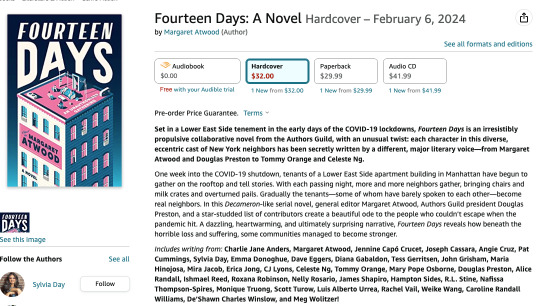
I feel like I'm in pretty good company here
(This is the cover and description of Fourteen Days, edited by Margaret Atwood, featuring my name alongside Margaret Atwood, Jennine Capó Crucet, Joseph Cassara, Angie Cruz, Pat Cummings, Sylvia Day, Emma Donoghue, Dave Eggers, Diana Gabaldon, Tess Gerritsen, John Grisham, Maria Hinojosa, Mira Jacob, Erica Jong, CJ Lyons, Celeste Ng, Tommy Orange, Mary Pope Osborne, Douglas Preston, Alice Randall, Ishmael Reed, Roxana Robinson, Nelly Rosario, James Shapiro, Hampton Sides, R.L. Stine, Nafissa Thompson-Spires, Monique Truong, Scott Turow, Luis Alberto Urrea, Rachel Vail, Weike Wang, Caroline Randall Williams, De’Shawn Charles Winslow, and Meg Wolitzer)
13 notes
·
View notes
Text
Here's my Jewish reading list so far
Finished:
-Here All Along - Sarah Hurwitz (highly recommend this, it was very enlightening)
-Choosing a Jewish Life - Anita Diamant
In Progress:
-Wrestling with God and Men - Steven Greenberg
To Read:
-Everything is God: The Radical Path of Nondual Judaism - Jay Michaelson
-This is Real and You Are Completely Unprepard - Alan Lew
-Judaism's Ten Best Ideas - Arthur Green
-Living Judaism - Wayne Dosick
-Your Guide to the Jewish Holidays - Cantor Matt Axelrod
-Gates of Shabbat: Shaarei Shabbat: A Guide for Observing Shabbat -Mark Dov Shapiro
-Essential Judaism: A Complete Guide to Beliefs, Customs & Rituals - George Robinson
-Entering Jewish Prayer: A Guide to Personal Devotion and the Worship Service - Reuven Hammer
-Living a Jewish Life - Anita Diamant, Howard Cooper
-Judaism: Everything You Need to Know About: Jewish Religion; Jewish Culture; and the Process of Converting to Judaism - Rachel Zahl
-Your People, My People - Lena Romanoff
-Jewish Living: A Guide to Contemporary Reform Practice - Mark Washofsky
-Jewish Literacy - Rabbi Joseph Telushkin
I have quite a bit of reading to do 😅 Most of these are on my Kindle though so I can read at work without lugging a big book around. I also have more on my wishlist that I haven't bought yet.
15 notes
·
View notes
Text
MY TOP 9 FAVORITE MOVIES

!! IN NO PARTICULAR ORDER !!
SCREAM (1996) horror/slasher ; 1hr 51mins (R) directed by: wes craven ; starring: neve campbell, matthew lillard , skeet ulrich , courtney cox
TOP GUN: MAVERICK (2022) action/adventure ; 2hrs 11mins (PG-13) directed by: joseph kosinski ; starring: tom cruise , miles teller , jennifer connely, val kilmer , glen powell
10 THINGS I HATE ABOUT YOU (1999) romance/comedy ; 1hr 37mins (PG-13) directed by: gil junger ; starring: julia stiles , heath ledger , joseph gordan levitt , larissa olynick , david krumholtz , andrew keegan
DONNIE DARKO (2001) sci-fi/drama ; 1hr 53mins (R) directed by: richard kelly ; starring: jake gylenhaal, maggie gylenhaal, drew barrymore , patrick swayze , seth rogan
SILENCE OF THE LAMBS (1991) thriller / horror ; 1hr 58mins (R) directed by: john dehm ; starring: anthony hopkins , jodie foster , ted levine , brooke smith , scott glenn
LADY BIRD (2017) coming of age / drama ; 1hr 33mins (PG-13) directed by: greta gerwig ; starring: saoirse ronan , timothee chalamet , laurie metcalf , beanie feldstein , odeya rush
MY GIRL (1991) romance / drama ; 1hr 43mins (PG) directed by: howard zeiff; starring: macaulay culkin , anna chlumsky , dan aykroyd , jamie lee curtis
TICK,TICK…BOOM! (2021) drama / biography ; 1hr 53mins (PG-13) directed by: lion manuel miranda ; starring: andrew garfield , vanessa hudgens , alexandra shipp , robin de jesus , joshua henry
HEREDITARY (2018) horror / drama ; 2hrs 6mins (R) directed by: ari aster ; starring: alex wolff, toni collette , milly shapiro , gabriel byrne , anne dowd
HONORABLE MENTIONS

12 ANGRY MEN (1957)
AMERICAN PSYCHO (2000)
THE OUTSIDERS (1983)
#movies#favorite movies#horror films#hereditary#silence of the lambs#my girl#tick tick boom#andrew garfield#lady bird 2017#greta gerwig#ari aster#donnie darko#10 things i hate about you#top gun 2#top gun maverick#scream 1996#tom crusie#tom cruise#miles teller#timothee chamalet#matthew lillard#jake gyllenhaal#anthony hopkins#julia stiles#heath ledger#joseph gordon levitt#12 angry men#american psycho#christian bale#patrick bateman
12 notes
·
View notes
Text

Germaine Richier (FR, 1904-1959)
Homme De La Nuit, 1954
(Man Of The Night)
Bronze, 29 X 32 X 10”
Gift To The Art Institute Of Chicago By Mr & Mrs Joseph Randall Shapiro (Sold)
2 notes
·
View notes
Photo

Title: Mank
Rating: R
Director: David Fincher
Cast: Gary Oldman, Amanda Seyfried, Lily Collins, Arliss Howard, Tom Pelphrey, Sam Troughton, Ferdinand Kingsley, Tuppence Middleton, Tom Burke, Joseph Cross, Jamie McShane, Toby Leonard Moore, Monika Gossmann, Charles Dance, Jack Romano, Adam Shapiro, John Churchill, Jeff Harms, Derek Petropolis, Sean Persaud, Paul Fox
Release year: 2020
Genres: history, drama
Blurb: 1930s Hollywood is reevaluated through the eyes of scathing social critic and alcoholic screenwriter Herman J. Mankiewicz as he races to finish the screenplay for Citizen Kane.
#mank#r#david fincher#gary oldman#amanda seyfried#lily collins#arliss howard#tom pelphrey#2020#history#drama
4 notes
·
View notes
Text
The part of motherhood that’s always terrified me the most, to the point of making me not want to do it, is the pregnancy and childbirth. How much school, doctors, men and our wider culture (movies, TV, magazines, social media, etc) conceal from you about what could and will happen to not only your body, but your mind.
Radical feminism helped me put this to bed. I still have the fear, I still don’t ever want to become a mother, but I don’t hate myself for it any more. I don’t think I’m selfish, I don’t think of myself as a murderer because I a) would probably terminate if I fell pregnant and b) am ending my ancestral lineage. Being in the traditionalist movement for five years I felt compelled to try, so fucking hard, to gaslight myself into thinking I wanted motherhood - to appease the 95% male crowd I was in. They don’t care about the risks to women and girls who endure pregnancy or become mothers, they are ignorant by choice about it (demonstrating perfectly what is missing from the ‘pro-life’ position… compassion for females).
To me they would say “these selfish thots are choosing to end tens of thousands of years of a family tree, and what for? So that they can live their life just for themselves?”
Yes.
Yes Matt Walsh, Dennis Prager, Andrew Tate, Paul Joseph Watson, Ben Shapiro, Jordan Peterson, and every single ex guy friend I have. That is exactly what I’m doing. Cope and seethe.
9 notes
·
View notes